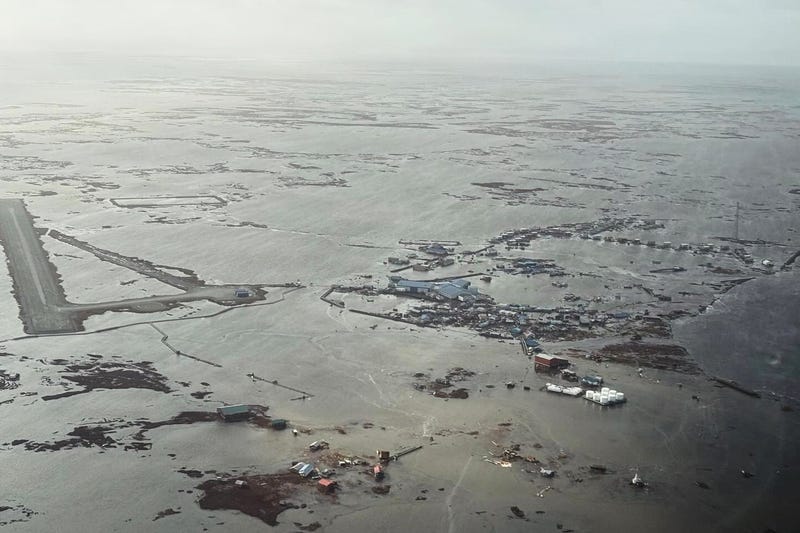
JUNEAU, Alaska (AP) — One of the most significant airlifts in Alaska history is underway by helicopter and military transport plane, moving hundreds of people from coastal villages ravaged by high surf and strong winds from the remnants of Typhoon Halong last weekend.
The storm brought record high water to two low-lying Alaska Native communities and washed away homes, some with people inside. At least one person was killed and two are missing. Makeshift shelters were quickly established and swelled to hold about 1,500 people, an extraordinary number in a sparsely populated region where communities are reachable only by air or water this time of year.
The remoteness and scale of the destruction created challenges for getting resources in place. Damage assessments have been trickling in as responders have shifted from initial search-and-rescue operations to trying to stabilize or restore basic services.
The communities of Kipnuk and Kwigillingok near the Bering Sea saw water levels more than 6 feet (1.8 meters) above the highest normal tide line. Some 121 homes were destroyed in Kipnuk, a village of about 700 people.
Leaders asked the state to evacuate the more than 1,000 residents from those villages, said Jeremy Zidek, a spokesperson with the state emergency management office.
About 300 evacuees were brought to Anchorage on Wednesday, about 500 miles (805 kilometers) east of the battered coastal villages, according to the state Department of Military and Veterans Affairs. People were being taken to the Alaska Airlines Center, a sports and events complex with capacity for about 400, Zidek said.
Shelter space closer to home — in the southwest Alaska regional hub of Bethel — was at capacity, with the food supply “near depletion,” officials said in a briefing Thursday.
Cell phone service had been restored in Kwigillingok, the report said, and restrooms were again working at the school in Kwigillingok, where about 350 people had sheltered overnight Tuesday, according to a state emergency management statement.
“Damage to many homes is severe, and the community leadership is instructing residents not to reenter homes due to safety concerns,” it said.
Damage was also serious in other villages. Water, sewer and well systems were inoperable in Napaskiak, and the Coast Guard on Thursday was expected to arrive in another village to assess a spill of up to 2,000 gallons (7,600 liters) of waste oil.
In Kwigillingok and Kipnuk, some homes cannot be reoccupied, even with emergency repairs, and others may not be livable by winter, emergency management officials said. Forecasters say rain and snow is possible in the region this weekend, with average temperatures soon below freezing.
Mark Roberts, the commander with the state emergency management agency, said the immediate focus was on “making sure people are safe, warm and cared for while we work with our partners to restore essential services.”
Zidek did not know how long the evacuation would take and said authorities were looking for additional shelters. The aim is to get people from congregate shelters into hotel rooms or dormitories, he said.
The crisis unfolding in southwest Alaska has drawn attention to Trump administration cuts to grants aimed at helping small, mostly Indigenous villages prepare for storms or mitigate disaster risks.
For example, a $20 million U.S. Environmental Protection Agency grant to Kipnuk, which was inundated by floodwaters, was terminated by the Trump administration, a move challenged by environmental groups. The grant was intended to protect the boardwalk residents use to get around the community, as well as 1,400 feet (430 meters) of river from erosion, according to a federal website that tracks government spending.
There was limited work on the project before the grant ended. The village had purchased a bulldozer for shipment and briefly hired a bookkeeper, according to Public Rights Project, which represents Kipnuk.
The group said no single project was likely to prevent the recent flood. But work to remove abandoned fuel tanks and other material to prevent it from falling into the river might have been feasible during the 2025 construction season.
“What’s happening in Kipnuk shows the real cost of pulling back support that was already promised to front line communities,” said Jill Habig, CEO of the Public Rights Project. “These grants were designed to help local governments prepare for and adapt to the growing effects of climate change. When that commitment is broken, it puts people’s safety, homes and futures at risk.”
___
Bedayn reported from Denver. Associated Press writer Michael Phillis in Washington contributed.